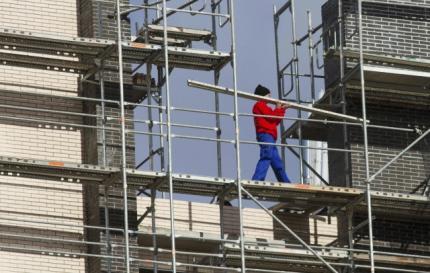Indonesia Q1 growth slowest in 4 years, but consumption buoy
Bareksa • 05 May 2014

A construction worker carries a plank during works on an unfinished apartment block outside Madrid (REUTERS/Paul Hanna)
Buoyant consumption and recovering investment were expected to bode well for the outlook this year
Bareksa.com - Gross domestic product in the January-to-March quarter expanded 5.21 percent from a year earlier, data from the statistics bureau showed on Monday. That was the slowest pace since the third quarter of 2009 and compared with 5.60 percent forecast in a Reuters poll. Growth was 0.95 percent on a quarterly basis against expectations of 1.26 percent.
The mining sector contracted 0.38 percent in the first quarter from the same period a year earlier, against a 3.91 percent expansion in October-December.
"Mining fell due to the export ban on some minerals and raw materials," said head of the statistics bureau, Suryamin, adding that the construction sector grew 6.54 percent from the same period a year earlier, boosted by the building of smelters.
Meanwhile, domestic consumption -- the main driver of the economy -- grew 5.61 percent from a year earlier and was stronger than 5.25 percent growth in the previous quarter, despite efforts by policymakers to restrain demand.
Buoyant consumption and recovering investment were expected to bode well for the outlook this year, analysts said.
"Investment growth has continued to recover and might have bottomed out as we have expected - and this is crucial for the GDP growth outlook going forward," said Gundy Cahyadi, economist at DBS in Singapore.
"Investment growth was the key drag to the economy in 2013, and a strong recovery this year will be significant for the prospect looking into 2015 and beyond."
Spot rupiah fell 0.1 percent to hit a session low of 11,535 per dollar after the data.
Indonesia has for the first time climbed into the ranks of the world's top 10 largest economies - a notch below the United Kingdom -- according to recent data from the World Bank.
Last year, its fortunes were far less sanguine. Hit badly by capital outflows from a wide current-account deficit, policy makers strived to cool down the economy by dampening imports and tightening fiscal and monetary policy.
The impact from massive tightening -- raising rates by a total 175 basis points between June and November last year -- is still filtering through the economy and has not been fully reflected in commercial bank lending rates.
The central bank has estimated a current-account deficit of below 3 percent of GDP this year, down from 3.3 percent in 2013 and a record 4.4 percent in the second quarter last year.
Meanwhile, the economic recovery in Asia and Europe helped Indonesia's export orders in April and prompted employers to boost their workforce for the first time since July, a HSBC Markit purchasing mangers' index survey showed.
The G20 economy on Friday liberalised a long-awaited negative investment list for several industries, to attract more long-term offshore money to the country.
Bank Indonesia, which will hold a policy rate meeting on May 8, has repeatedly signalled that monetary policy will remain tight to ensure a moderation in growth in spite of recent improvements in trade and inflation. Most economists expect BI to keep rates on hold at 7.50 percent.
Inflation has moderated and the rupiah has become Asia's top performing currency this year from being its worst last year. It is up 5.7 percent against the dollar so far this year.
The central bank is eyeing economic growth of 5.5 to 5.9 percent this year, with inflation easing to 3.5-5.5 percent from 8.38 percent last year. (Source : Reuters)